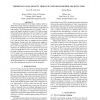Free Online Productivity Tools
i2Speak
i2Symbol
i2OCR
iTex2Img
iWeb2Print
iWeb2Shot
i2Type
iPdf2Split
iPdf2Merge
i2Bopomofo
i2Arabic
i2Style
i2Image
i2PDF
iLatex2Rtf
Sci2ools
FPL
2009
Springer
2009
Springer
Improving logic density through synthesis-inspired architecture
We leverage properties of the logic synthesis netlist to define both a logic element architecture and an associated technology mapping algorithm that together provide improved logic density. We demonstrate that an “extended” logic element with slightly modified K-input LUTs achieves much of the benefit of an architecture with K+1-input LUTs, while consuming silicon area close to a K-LUT (a K-LUT requires half the area of a K+1-LUT). We introduce the notion of “non-inverting paths” in a circuit’s AND-inverter graph (AIG) and show their utility in mapping into the proposed logic element. Results show that while circuits mapped to a traditional 5-LUT architecture need 14% more LUTs and have 12% more depth than a 6-LUT architecture, our extended 5-LUT architecture requires only 7% more LUTs and 2.5% more depth than 6-LUTs, on average. Nearly all of the depth reduction associated with moving from K-input to K+1-input LUTs can be achieved with considerably less area using exten...
| Added | 24 Jul 2010 |
| Updated | 24 Jul 2010 |
| Type | Conference |
| Year | 2009 |
| Where | FPL |
| Authors | Jason Helge Anderson, Qiang Wang |
Comments (0)

